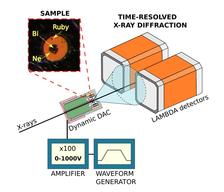Schematic showing the dynamic diamond anvil cell and detector setup at the PETRA III beamline P02.2 where the experiments were performed. Insert shows the Bi sample surrounded by Ne in the sample chamber of the diamond anvil cell (Credit: R. Husband, DESY)
An international team of researchers led by DESY and Lawrence Livermore National Laboratory (US) investigated the influence of compression rate on pressure-induced phase transitions in bismuth. Elemental bismuth undergoes multiple structural phase transitions at pressures below 100,000 atmospheres (~10 GPa), adopting several high-pressure polymorphs with remarkable structural complexity. Bismuth also exhibits unusual behaviour when it is heated at ambient pressure, as its density decreases during melting similarly to water. Consequently, bismuth has been extensively studied using both conventional static diamond anvil cell (DAC) and dynamic shock and ramp compression techniques since the early days of high-pressure science. In particular, the pressure-induced structural pathway is known to be heavily dependent on the timescale of the experiment. However, the behaviour of bismuth at intermediate strain rates has remained essentially unexplored.
The team of scientists, including researchers from the University of Bayreuth, European XFEL and SLAC (US), measured the influence of the compression rate on the pressure-induced Bi-III/Bi-V structural phase transition in bismuth.
In these experiments, bismuth samples were compressed using the latest generation of dynamic DAC developed by scientists from Lawrence Livermore National Laboratory (LLNL) and DESY, which employs piezo actuators to compress samples at rates up to 160 TPa/s. By employing high-speed, time-resolved X-ray diffraction detectors at the PETRA III beamline P02.2 for experiments at extreme conditions, they mapped the structural behaviour of bismuth at compression rates spanning 5 orders of magnitude with an unprecedented time resolution of 0.25 milliseconds. This allowed to accurately pinpoint the onset phase transition pressure at previously unexplored compression rates which are not accessible using conventional static or dynamic compression techniques.
The results of this study, recently published in Scientific Reports, showed that the Bi-III/Bi-V structural transition shifted to higher pressure with increasing compression rate. This holds true for both powder and foil sample types, as well as for samples loaded with and without neon gas. A maximum shift of 2.5 GPa was observed in bismuth samples loaded in neon gas which is most likely related to kinetic hindrance associated with the transition.
These results illustrate the potential of dynamic DAC drivers to revolutionise the landscape of experiments at synchrotron sources, paving the way for future studies of transition kinetics at previously inaccessible compression rates. By utilising kHz (1000 Hz) photon counting detectors to study a high-Z material like bismuth, this research represents the current limit of fast compression experiments at 3rd generation synchrotron sources. Next generation sources such as PETRA IV should enable these experiments to be extended to lighter elements with low-Z.
In addition, the large volume of data generated from these experiments illustrates the data analysis challenges that will be faced in future time-resolved experiments: the results presented in this paper are the product of over 50 compression ramps which generated over 70,000 diffraction images. The first author of the publication Rachel Husband said “With this study, we believe we have reached a milestone in dynamic DAC studies at synchrotron sources, and hope that this acts as a benchmark for future fast compression studies utilising similar techniques.”
Reference:
Compression-rate dependence of pressure-induced phase transitions in Bi, R. J. Husband, E. F. O’Bannon, H.-P. Liermann, M. J. Lipp, A. S. J. Méndez, Z. Konôpková, E. E. McBride, W. J. Evans and Z. Jenei, Scientific Reports (2021). DOI: 10.1038/s41598-021-94260-y








